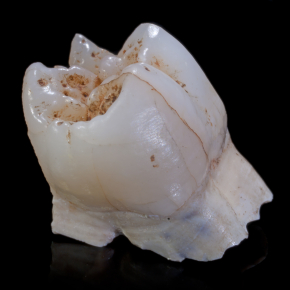New knowledge on Paranthropus robustus
A study published inNature Ecology & Evolutionby Vincent Balter on geochemical profiles in the enamel of South African hominins Paranthropus robustus indicates that this species exploited both forest and grassland habitats, and that the individuals did not move in a manner analogous to African great apes.
Upper right third molar of a “Paranthropus robustus”. It is part of a set of fossilized teeth of hominins of the genera Australopithecus, Paranthropus and Homo, having lived around 2 million years before our era in South Africa.© José BRAGA/Didier DESCOUENS/CNRS Images

To the 28 geochemical profiles obtained from the 87Sr/86Sr and elementary Sr/Ca and Ba/Ca isotopic ratios of 20 teeth of P. robustus from Swartkrans and Kromdraai, scientists associated the ages of formation of the enamel to reconstruct time series. They predicted the range of P. robustus individuals using 87Sr/86Sr isotope signature mapping and finally performed spectral analyses of time series.
Although variable in early-formed teeth (due to the varied geographical origins of maternal Sr), the 87Sr/86Sr ratio converges in later-formed third molars, providing an unambiguous marker for local Sr supply. Scientists describe this chronological convergence as the “isotopically delimited area of exploitation” (LIDEA), the product of all locally exploited habitats after weaning and before puberty.
The identification of the LIDEA sheds light on the multiple issues of adaptation, habitat, and residence. Firstly, LIDEA is consistent neither with a specialization for the riparian forest nor that for the open dolomitic grassland, but suggests a mixture of both. Secondly, the geographical assignment based on the mapping of the isotopic signature of Sr allows the estimation of a territory compatible with that of modern hunter-gatherers. Thirdly, the data do not support the hypothesis of male philopatry and female dispersal, but rather suggest a highly variable immigration pattern. Finally, the spectral analysis revealed many periodicities that could be related to seasonality, resource scarcity or lunar cycles.
The obvious application of this research is to extend to other samples to include other ancient hominids from the region, notably early Homo and Australopithecus, in order to answer the crucial question of niche exploitation and behavior among ancient hominids.